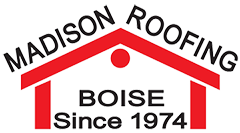While there is no set answer to this question because it all depends on your roof’s quality and structural integrity, the good news is that your roof was made to withstand the harshest winter conditions. In fact, home builders and engineers are careful to ensure the roofs they design are capable of holding up under heavy snow and ice.
Below are some average snowfalls for nearby locations in Idaho:
| County | Average Snowfall (inches) |
| Boise | 18 |
| Nampa | 19.1 |
| Caldwell | 11.3 |
| Twin Falls | 24.2 |
| McCall | 132.2 |
| Idaho City | 92.2 |
While we’ve been getting plenty of snowfall in the Treasure Valley, these averages are something your roof should be able to handle.
Building Standards Require Roofs to Meet Minimums
In Idaho, local municipalities have strict standards and building codes to ensure homes are built for safety. Each county will experience different degrees of winter weather. Therefore, depending on where you live, your city may require additional elements for roofing systems than others. That’s why it’s important to understand building permits when building or renovating your home. Why? The last thing you need is a poorly constructed roof that doesn’t hold up to the conditions in your area.
Snow Melts Into Icy Layers
Often when there’s snow on your roof, there’s ice beneath it. This can make your roof extremely treacherous. As warm air inside your home rises and hits the roof, it melts away a portion of the snow that comes into direct contact with your roof. When temperatures drop, this melted snow re-freezes, creating a layer of ice beneath the snow buildup.
How Will I Know If There’s Too Much Snow On My Roof?
When there’s too much snow on your roof, you’ll start to notice the strain, starting from the inside of your home. If you’re worried about the amount of weight on your roof, go to the upper level of your home and check the doors. If there’s too much snow on the roof, it will start to warp the door frames, making them stick or hard to open.
Keep in mind that the steeper your roof, the more favorable it may be when it comes to heavy snowfall. Steeply pitched roofs cause snow to slide down the roof before causing structural issues. Lower sloped or flat roofs run a higher risk of collapsing under the weight of heavy snow and ice that pushes the limits.
Can I Remove The Snow From My Roof?
At Madison Roofing, we don’t ever recommend climbing your roof and shoveling off the snow during the winter. Why? Not only could you damage your roof by tearing or puncturing its shingles, but you could also fall or slip, resulting in serious injury or death. Furthermore, your roof could collapse altogether with you on top of it if it can’t handle the weight of the snow on it.
Roof Quality and Workmanship Matter
Assuming your roof was installed by a professional roofing company in Boise, you shouldn’t have to worry about any leaks developing from the ice and snow on your roof. Unfortunately, however, many roofs are installed incorrectly. Some flyby roofers lack patience or knowledge in critical areas of a roof, such as the flashing details around skylights, chimneys, and pipes. When this happens, ice and snow will often cause a roof to leak, causing serious water damage to your home. To prevent this from happening, it’s essential to get a professional roof inspection before winter. This is especially important for flat or low-sloped roofs. Melting snow, which would normally run off a steep roof, can pool on a flat roof, causing leaks if a roof isn’t installed tightly.
Can I Repair or Replace My Roof During the Winter?
Yes. A roof can be replaced during the winter if it’s done correctly. However, most roofing companies in Boise will wait until the snow has cleared before starting a major project. If a roof is covered in snow, roofers will simply clear it off before they start working. During the winter, the roofers at Madison Roofing pay close attention to the temperatures outside. In fact, most materials can be installed during any weather, with the exception of fiberglass shingles that should only be installed when it’s 40˚ F or warmer outside.
While asphalt shingles can be installed in cold weather, doing so requires extra care, so they don’t crack during installation. Extremely cold temperatures can also impact the air pressure of our pneumatic guns, making it necessary to hand nail shingles. Additionally, asphalt shingles need a perfect seal with their overlapping counterparts. Because these seals are greatly assisted by the heat of the sun, it may take several days for the weather to warm up enough to bond them. If temperatures are below 40˚ F, the sealant may need to be hand-applied under each shingle to create a quick bond.
Rubber and rolled roofing can also be installed during the winter, but care will also need to be given to the temperatures outside to ensure proper bonding of the adhesives. While spring is the best time to replace the roof of your house, you can still get the job done during the winter if necessary. Like we mentioned above, if you are experiencing a leaky roof or any other issue, it’s essential to address the problem as soon as possible to prevent further damage to your home.
Contact the Professionals at Madison Roofing
Before climbing a ladder in freezing temperatures with a shovel in your hand, contact the professionals at Madison Roofing. Our expert roofers can help you determine whether snow needs to be removed from your roof or if you need any repairs. Fill out our online form or give our Treasure Valley office a call at (208) 344-5379 for a no-cost, no-obligation quote.








